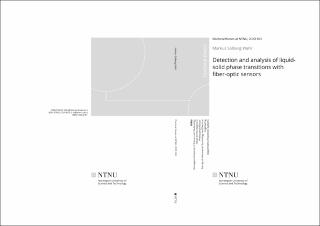| dc.contributor.author | Wahl, Markus Solberg | |
| dc.date.accessioned | 2020-05-06T06:21:18Z | |
| dc.date.available | 2020-05-06T06:21:18Z | |
| dc.date.issued | 2020 | |
| dc.identifier.isbn | 978-82-326-4675-3 | |
| dc.identifier.issn | 1503-8181 | |
| dc.identifier.uri | https://hdl.handle.net/11250/2653401 | |
| dc.description.abstract | Fiber-optic sensors offer unique benefits within the field of experimental thermodynamics due to their small size and inert all-fiber design. Interrogation of the reflected signal enables insertion probes able to monitor harsh conditions, with fast response and minimal impact on the system. This thesis presents the development process – from understanding the fabrication and the associated challenges, through a proof-of-concept realization, to the application of fiberoptic sensors to study phase transitions.
The multi-mode fiber interferometers used are a simple and robust class of fiber-optic sensors, which can be designed to be sensitive to temperature, strain and refractive index (RI). The interference spectrum depends solely on the propagation constants and the geometry of the sensor, which is fabricated by splicing a section of coreless or thin-core fiber to the distal end of an optical fiber. Despite the simple fabrication, it is challenging to achieve a reproducible optical response. The thesis addresses this by investigating how inaccuracies in the geometry affect the ensemble of modes that is excited, and how this affects the produced spectrum. Guided-mode propagation simulations show that deviations in the cleave angle of the fiber end-face are more significant than inaccuracies in the spliced region. In the experimental results, however, large variations are observed independent of the cleave angle. It is concluded that the spliced region, which is more difficult to measure, plays a significant role in the produced spectrum.
The thesis proceeds to demonstrate how multi-mode fiber interferometers can be used in conjunction with a fiber-Bragg grating (FBG) to analyze phase transitions in binary mixtures of ethanol and water. The temperature and strain sensitivity of the FBG is used to decouple these parameters from the multi-mode interferometer (MMI) response. The remaining RI sensitivity of the MMI is used to measure the increased ethanol concentration caused by pure ice forming in the mixture. The measured melting points show excellent agreement with tabulated values.
The sensor system developed is then used to study ice formation in supercooled water-alcohol mixtures. The results are compared to theoretical predictions from heterogeneous nucleation theory. The effect on the nucleation barrier from solute type and concentration is studied, as well as the reduction in this barrier as a function of container material and pre-experiment rinsing procedures. Because of the dependency of the nucleation rate on the self-diffusivity of water, ice growth rates are measured in different ethanol concentrations to estimate the diffusivity at the liquid-solid interface. | en_US |
| dc.language.iso | eng | en_US |
| dc.publisher | NTNU | en_US |
| dc.relation.ispartofseries | Doctoral theses at NTNU;2020:163 | |
| dc.relation.haspart | Paper 1: Wahl, Markus Solberg; Wilhelmsen, Øivind; Hjelme, Dag Roar. Addressing Challenges in Fabricating Reflection-Based Fiber Optic Interferometers. Sensors 2019 ;Volum 19.(18) s. 1-14
https://doi.org/10.3390/s19184030
This article is an open access
article distributed under the terms and conditions of the Creative Commons Attribution
(CC BY) license (http://creativecommons.org/licenses/by/4.0/). | en_US |
| dc.relation.haspart | Paper 2:
Wahl, M.S., Wilhelmsen, Ø., Hjelme, D.R.
Using Fiber-Optic Sensors to Give Insight into Liquid-Solid Phase Transitions in Pure Fluids and Mixtures | en_US |
| dc.relation.haspart | Paper 3:
Wahl, M.S., Aasen, A., Hjelme, D.R., Wilhelmsen, Ø.
Ice Formation and Growth in Supercooled Water–Alcohol Mixtures: Theory and Experiments with Dual Fiber Sensors. | en_US |
| dc.title | Detection and analysis of liquid-solid phase transitions with fiber-optic sensors | en_US |
| dc.type | Doctoral thesis | en_US |
| dc.subject.nsi | VDP::Technology: 500::Electrotechnical disciplines: 540::Electronics: 541 | en_US |
